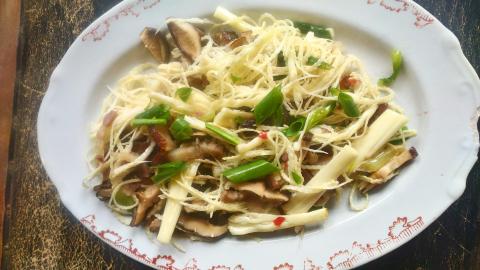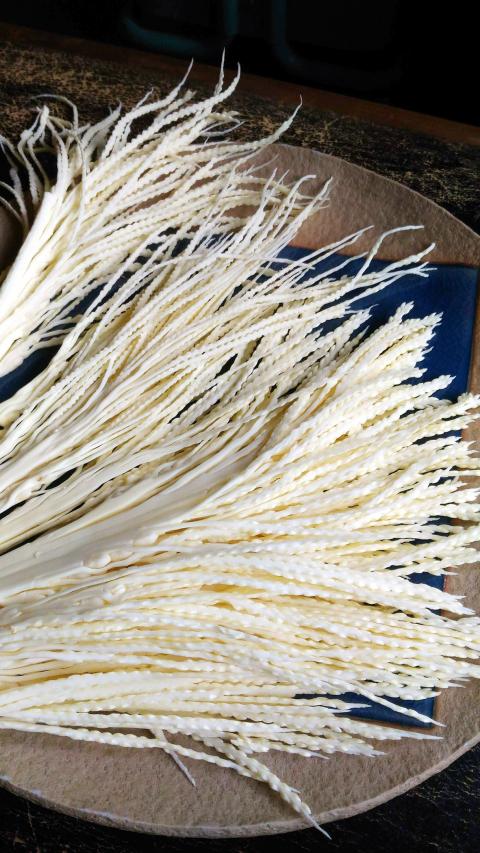Few foods come with as many health caveats as betel nut, the chewing of which remains closely associated with Taiwanese culture despite strenuous government effort to discourage the practice. The betel nut has psychoactive substances that promote its use as a stimulant, and it is sold around Taiwan, most famously by betel nut beauties, scantily clad women who are displayed in glass shop fronts.
HEALTH HAZARD
The beauties have gained Taiwan some international notoriety, but apart from the sexual exploitation inherent in this manner of marketing, the chewing of betel nut is also closely associated with oral and other cancers and its use generally acknowledged as a health hazard.

Photo: Ian Bartholomew
That said, it remains a highly valuable crop and huge areas are dedicated to its cultivation, particularly fragile hillside lands in southern Taiwan, where it is responsible for server environmental degradation. It is widely accepted as a major culprit in a number of devastating mud slides that have destroyed lives and communities. It’s high value means that efforts to curb the planting of betel nut around Taiwan have had limited effect and it is still a major feature of scenery in southern Taiwan.
Overall, there is really not much of an upside to betel nut as a commercial crop. Nevertheless, one culinary curiosity does emerge from this harmful agriculture. This is the betel nut flower (檳榔花), which is sometimes found on the menus of Taiwanese eateries dealing in local specialties and the cuisine of Taiwan’s indigenous peoples.
Despite the notoriety of the betel nut and its close association with Taiwan culture, betel nut flower is not a regular feature in the supermarket vegetable aisle. It has a relatively short season around this month, and is most likely to be found in traditional markets. In restaurants, it is usually served either stir fried or as a cold dish, appreciated for its crunchy texture.

Photo: Ian Bartholomew
The reason that the government seeks to discourage the chewing of betel nut is for the simple fact that this habit can cause cancer, particularly of the mouth. The fact that it remains popular is due to its effects as a powerful stimulant, and despite best efforts, remains popular, particularly among Taiwan’s working class who use it to get thought the physical demands of manual labor or soul-crushingly long hours behind the wheel of long haul trucks.
It is no coincidence that major highway interchanges in southern Taiwan remain a focal point for the betel nut beauties, providing the double whammy of sexual titillation and drug-induced vitality. Cancer, the gradual disintegration of teeth, foul breath, a diseased mouth and throat, can all seem like a high price to pay for a momentary high.
Despite its ill effects, like many expats in Taiwan, I have tested its psychoactive properties as part of the “Taiwan experience.” For myself, a single test was enough to put any notion of establishing solidarity with the Taiwan working class through the participation in the betel nut ritual behind me.
Others have found betel nut to be an interesting and exciting experience, so I will not seek to judge on this issue, but it should be emphasized that regardless of the kind of high you can get from betel nut, the powerful alkaloids it contains will certainly not do you any good in the long run. Betel nut is most often sold with flavoring agents such as slacked lime that (slightly) improve its flavor, but which have terrible effects on oral health and hygiene.
While the flower does not present the carcinogenic dangers of the nut, most sources recommend its consumption only in moderation, as it contains alkaloids such as arecoline, which can lead to sweating and difficulty in breathing. Nausea, vomiting and stomach pain are also associated with excessive consumption of betel nut flower.
NOT ALL DOOM AND GLOOM
It is not all doom and gloom for the betel nut flower, as eaten in moderation it can stimulate digestion and some studies have even shown that arecoline in some forms may be active in retarding the onset of dementia. Betel nut also has a number of uses in ayurvedic medicine.
On the culinary front, the betel nut flower is prized for its crunchy texture and its fresh flavor that can stand out even against strong flavors. As delicious as it is, I am only able to eat it in very small quantities, primarily due to the fact that while the chemical properties of the flower are much slighter than that of the nut, I find that after three or four mouthfuls, I sometimes feel a quite distinct nicotine buzz. For those who like this sensation, betel nut flower is a must-try, but for myself, I find the whole experience rather disturbing.
Another part of the appeal of betel nut flower for the culinary adventurer is its appearance. Its ivory fronds are really rather beautiful and I can fully appreciate its appeal both as a visual and flavor element of a dish, but in all honesty eating betel nut flower is more about engaging with the Taiwan experience rather than having a healthy culinary experience.
Fried Betel Nut Flower with Chinese Mushrooms
Recipe
(serves two)
It may be the simple lack of culinary invention, but betel nut flower is generally served in one of only two methods. It is either fried or blanched in boiling water and dressed with a spicy savory dressing. The combination with Chinese mushrooms is a standard combination and a sprinkling of chili is very handy in bringing out the flavor of the betel nut flower and an addition I would strongly recommend even if you are not particularly partial to spicy flavors. While I enjoy the flavor and texture of betel nut flower, I sometimes find that some batches have a more powerful effect than others, and while I can enjoy the flower simply as a vegetable, on occasion I do feel that it is also providing a sometimes not entirely welcome narcotic effect. This is something to be aware of when preparing this dish.
Ingredients
200g betel nut flower, fronds cut
into segments
100g preserved pork belly
20g dried Chinese mushrooms
2 cloves of garlic, minced
2 stems spring onion, cut into segments
2 tbsp olive oil
salt and white pepper to season
Directions
1. Blanch the preserved pork belly in boiling water for about 5 minutes. Allow to cool and slice thinly.
2. Soak the Chinese mushrooms in boiling water for about 5 minutes, or until soft, then cut away the stem, and slice finely. The water can be discarded.
3. Heat a skillet and add oil over low heat. Put in the preserved pork belly and allow the fat to render slightly, about 3 minutes. Add the garlic and fry for another minute until fragrant.
4. Add the sliced Chinese mushroom and spring onions. Turn up heat to medium and fry for another minute. Add the betel nut flower segments and stir, coating the fronds in the fragrant oil. Cook for about 2 minutes. The fronds should remain crunchy.
5. Season with salt and white pepper. Serve with white rice.
Ian Bartholomew runs Ian’s Table, a small guesthouse in Hualien. He has lived in Taiwan for many years writing about the food scene and has decided that until you look at farming, you know nothing about the food you eat. He can be contacted at Hualien202@gmail.com.

April 14 to April 20 In March 1947, Sising Katadrepan urged the government to drop the “high mountain people” (高山族) designation for Indigenous Taiwanese and refer to them as “Taiwan people” (台灣族). He considered the term derogatory, arguing that it made them sound like animals. The Taiwan Provincial Government agreed to stop using the term, stating that Indigenous Taiwanese suffered all sorts of discrimination and oppression under the Japanese and were forced to live in the mountains as outsiders to society. Now, under the new regime, they would be seen as equals, thus they should be henceforth

Last week, the the National Immigration Agency (NIA) told the legislature that more than 10,000 naturalized Taiwanese citizens from the People’s Republic of China (PRC) risked having their citizenship revoked if they failed to provide proof that they had renounced their Chinese household registration within the next three months. Renunciation is required under the Act Governing Relations Between the People of the Taiwan Area and the Mainland Area (臺灣地區與大陸地區人民關係條例), as amended in 2004, though it was only a legal requirement after 2000. Prior to that, it had been only an administrative requirement since the Nationality Act (國籍法) was established in

With over 80 works on display, this is Louise Bourgeois’ first solo show in Taiwan. Visitors are invited to traverse her world of love and hate, vengeance and acceptance, trauma and reconciliation. Dominating the entrance, the nine-foot-tall Crouching Spider (2003) greets visitors. The creature looms behind the glass facade, symbolic protector and gatekeeper to the intimate journey ahead. Bourgeois, best known for her giant spider sculptures, is one of the most influential artist of the twentieth century. Blending vulnerability and defiance through themes of sexuality, trauma and identity, her work reshaped the landscape of contemporary art with fearless honesty. “People are influenced by

Three big changes have transformed the landscape of Taiwan’s local patronage factions: Increasing Democratic Progressive Party (DPP) involvement, rising new factions and the Chinese Nationalist Party’s (KMT) significantly weakened control. GREEN FACTIONS It is said that “south of the Zhuoshui River (濁水溪), there is no blue-green divide,” meaning that from Yunlin County south there is no difference between KMT and DPP politicians. This is not always true, but there is more than a grain of truth to it. Traditionally, DPP factions are viewed as national entities, with their primary function to secure plum positions in the party and government. This is not unusual